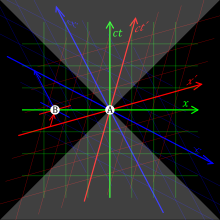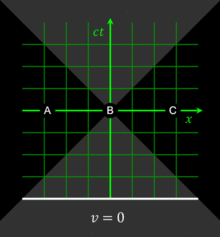
Back نسبية التزامن Arabic Relativnost současnosti Czech Relativität der Gleichzeitigkeit German نسبیت همزمانی Persian יחסיות הסימולטניות HE Az egyidejűség relativitása Hungarian Միաժամանակության հարաբերականություն Armenian Relativitas simultanitas ID 동시성의 상대성 Korean Релативност на едновременоста Macedonian



In physics, the relativity of simultaneity is the concept that distant simultaneity – whether two spatially separated events occur at the same time – is not absolute, but depends on the observer's reference frame. This possibility was raised by mathematician Henri Poincaré in 1900, and thereafter became a central idea in the special theory of relativity.
© MMXXIII Rich X Search. We shall prevail. All rights reserved. Rich X Search